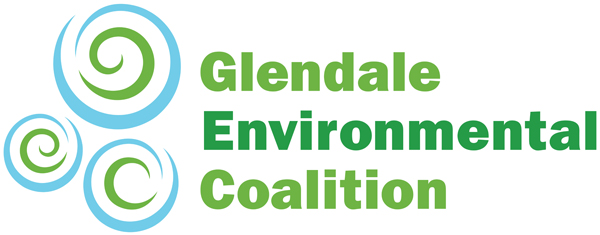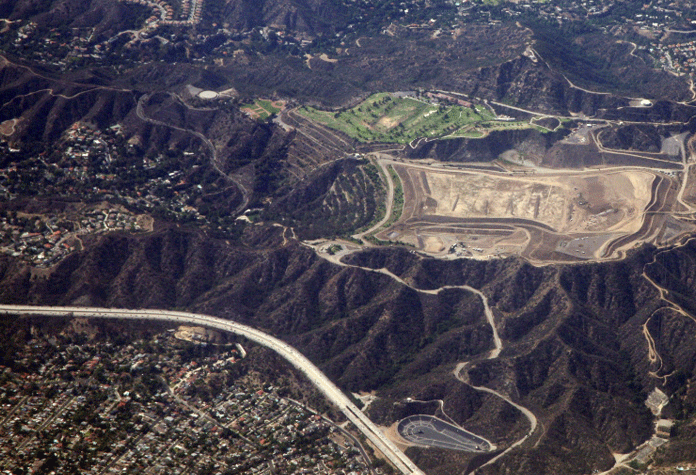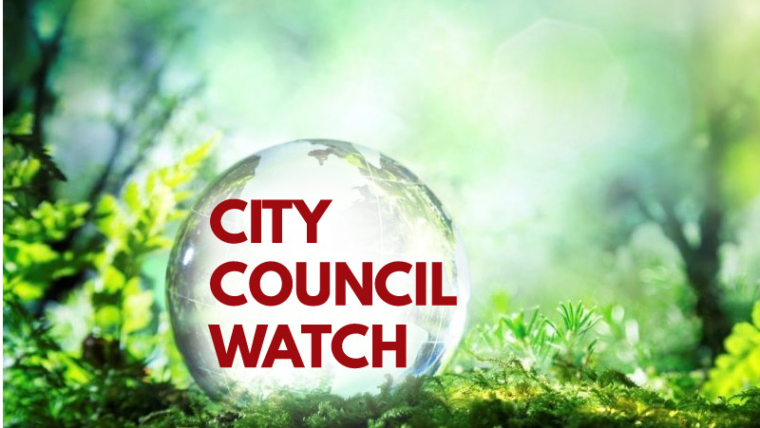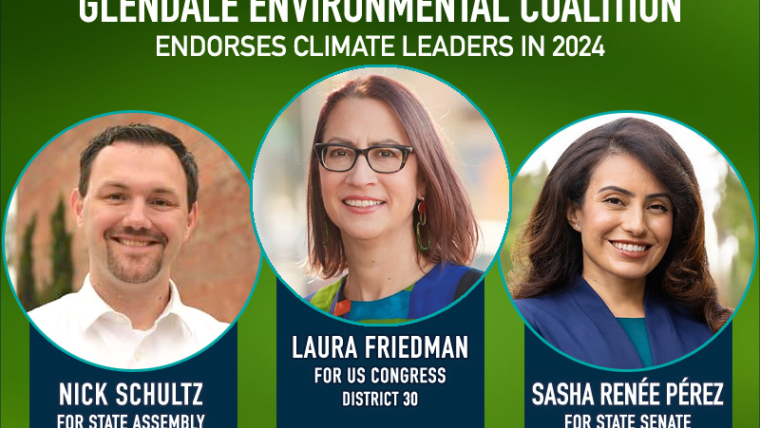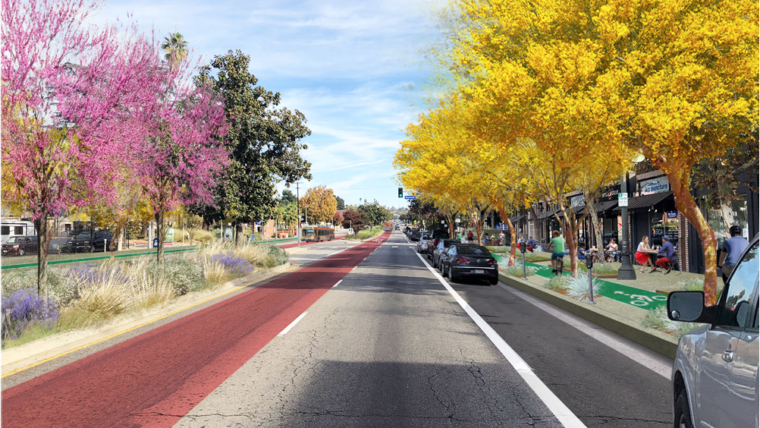FAQ re GWP’s Proposal for the Scholl Biogas Plant
What is the reasoning Glendale Water & Power provides for building a biogas plant?
To provide “renewable” power generated within the city at the Scholl Canyon Landfill and to utilize the landfill gas as a renewable energy source. Burning the landfill methane in a power plant will add to Glendale’s renewable energy credits, but the power plant would generate a higher level of pollutants that can have detrimental health effects. Furthermore, the amount of power the plant would produce may not justify the financial investment over the plant’s lifetime. This is because Glendale will be implementing a program to divert organics from the landfill starting in January 2022, and the landfill is scheduled to close in 5 years, both of which will reduce the amount of methane the landfill will produce.
Isn’t energy from burning landfill gas a renewable energy source?
It is classified as “renewable” for the purposes of the state’s mandates for renewable power, but it is not renewable or clean in the same sense as solar or wind, which have an unlimited supply. Burning the gas produces air pollutants such as NOx, volatile organics, particulate matter and more.
Why did both the Planning Commission and the Sustainability Commission vote down Glendale Water & Power’s plans for a biogas plant even though the Glendale Water and Power Commission voted in favor of the project?
The Planning Commission said that the project did not satisfy the requirements for the conditional use permit including compatibility with the Glendale general plan, compatibility with future recreation use, and concerns regarding health, safety, and the environment. The Sustainability Commission focused on wanting clean energy, concerns about pollution, and the inadequacies of the Environmental Impact Report.
Environmental, Health, and Safety Implications:
Why is a biogas plant bad for the environment?
The plant emits a much higher level of key pollutants (nitrogen oxides [NOx], carbon monoxide [CO], volatile organic compounds [VOCs], particulate matter [PM], and sulfur oxides [SOx]) than the current flares, and new flares will soon be installed that will emit even less than the current flares. In addition, there would be a large keep-out zone around the biogas plant (more than a football field in all directions) that would have unsafe air for workers or kids.
These figures are directly from GWP’s Environmental Impact Report for the Scholl Biogas Plant Project. They use 2018 pollutant levels to project the amount of pollutant increase that would come from a Scholl Biogas Plant:
NOx: increase from 90 lb/day to 190 lb/day, 111% increase (more than double)
CO: increase from 42 lb/day to 928 lb/day, 2,110% increase (20-fold increase)
VOC: increase from 7 lb/day to 121 lb/day, 1,629% increase (also over a 10 times increase)
PM10: increase from 62 lb/day to 71 lb/day, 14.5% increase
PM2.5: increase from 62 lb/day to 71 lb/day, 14.5% increase
SOx: increase from 46 lb/day to 93 lb/day, 102% increase (more than double)
Comparing the AQMD website pollution figures for 2020 for flaring versus the pollution emission information listed in the Environmental Impact Report for the Scholl Biogas Plant Project, there will be an even more significant pollution increase:
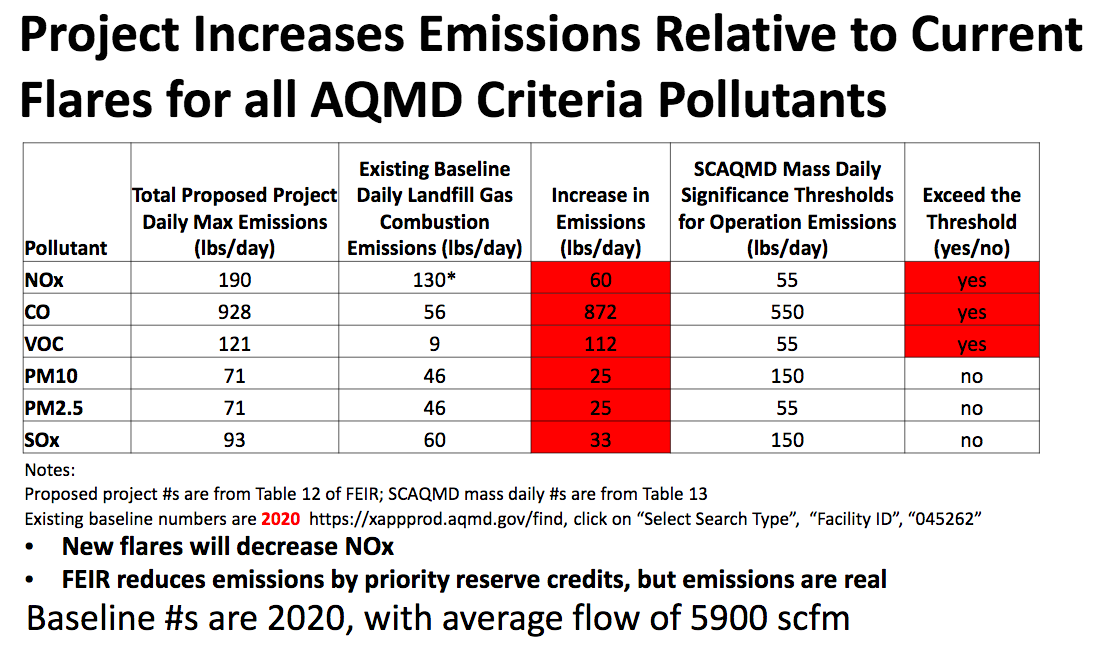
Pollutant Percentage Increases
NOx: increase from 130 lb/day to 190 lb/day, 46% increase
CO: increase from 56 lb/day to 928 lb/day, 1,558% increase
VOC: increase from 9 lb/day to 121 lb/day, 1,244% increase
PM10: increase from 46 lb/day to 71 lb/day, 54% increase
PM2.5: increase from 46 lb/day to 71 lb/day, 54% increase
SOx: increase from 60 lb/day to 93 lb/day, 55% increase
What are the health ramifications of a biogas plant?
The pollutants mentioned above cause smog and a variety of health hazards including harm to the respiratory system, the central nervous system, the immune system, the reproductive system, cellular function, and brain development in children.
Are there other environmental, health, and safety implications?
Yes, there are many others. Another major safety impact is increased fire risk from an above-ground pressurized landfill gas line (the flares don’t require elevated pressures), an above-ground natural gas line, lube and waste oil tanks (2,000 and 3,000 gallon capacity, respectively), and the engines themselves. If there were a break in the pressurized landfill gas line, people as far away as 60 meters (about 200 feet) could get skin burns, and of course it could start a fire in the brush (GWP only plans to clear brush in a radius of 100 feet).
There is a planned 12,000 gallon aqueous ammonia tank. If the ammonia were released suddenly, people as far away as 150 feet would get a dose just under the amount for serious adverse effects.
GWP plans to add at least 1.5% natural gas, purchased from SoCalGas, to the landfill gas burned in the plant, which will increase greenhouse gases in the atmosphere.
The plan would permanently impact 4 acres of land, with a variety of biological effects.
The landfill is built on fractured rock, so if there are any spills, they could easily impact the water in the surrounding areas. And the site is ⅓ mile from a major earthquake fault.
Isn’t the Scholl Canyon Landfill zoned for recreational use?
It is zoned special recreation and restricted residential.
Economics
How much power would the biogas plant produce?
GWP claims the plant would produce 12 MW, but they don’t seem to be counting the power needed to compress and cool the gas, energy for cooling the engines, and maintenance downtime, all of which are necessary for the plant’s operation. In addition, this claimed amount would be the power that would be generated within the next few years. Over time, with the anticipated closure of the landfill in 4-5 years and with diversion of organics (yard waste and food waste, the materials that form the methane), the methane generated and the resulting power will fall considerably. They claim the plant will generate 9 MW in 10 years and 6 MW or less in 20 years. These are overestimates for the same reasons.
What is the cost of this biogas plant?
We have heard $40 million, but that may not be a current number. In addition, there will be maintenance costs as well as costs for any natural gas they add to the landfill gas, which will likely continue to rise in cost over the next couple of decades.
Energy Production (or lack thereof)
Isn’t Glendale Public Waste implementing a new plan to divert organic waste from the Scholl Canyon Landfill? If so, how would this affect the methane production?
Since January 2020, 80% of yard waste has been diverted from the landfill. Starting in January, 2022, organic waste from apartment buildings of more than 5 units, homes, and commercial properties (including schools) will be diverted from the landfill. This is part of what will contribute to the drop in methane over time. (SB 1383 requires a reduction in the statewide disposal of organic waste by 50% by January 1, 2020, and by 75% by January 1, 2025, based on 2014 levels.)
When is the Scholl Canyon Landfill scheduled to close?
It will close when it is “full,” currently estimated as 2025 or 2026, depending on how much waste goes into the landfill between now and then.
Alternatives to the Biogas Plant:
What other solutions are there for the landfill methane?
The landfill methane has to be destroyed or captured—and it is, by state law. Currently it is flared at the landfill. Contrary to the name, these flares have no visible flames. And, the flares destroy the methane and also emit far less pollution than the biogas plant would. Every landfill has them.
Continuing with current flaring for the time being is the best choice, especially because less-polluting flares are currently in the planning stage. That keeps options open and allows time to explore other paths forward that the community can embrace as in the best interests of all Glendale residents.
There are other solutions such as piping the gas somewhere else and burning it there, but these are not great options. Two alternatives discussed in the EIR involve piping the gas elsewhere. These alternatives either create more air pollution close by or require additional expense to clean up the gas. (The gas had previously been piped to the Grayson Power Plant and burned there; this practice was halted in 2018 because it superseded the AQMD’s limitations. Piping the gas to the Grayson Power Plant will create more pollution in that part of Glendale and is not a good solution, plus it violates state air quality regulations.)
Another option is cleaning up the gas to get rid of the main other constituents (carbon dioxide, nitrogen, and oxygen) and selling it to the gas company.
There are other technologies that were mentioned in the EIR, such as fuel cells, but these technologies may need further development to be financially feasible at the level needed.. That said, the EIR didn’t lay out alternatives with other technologies in enough detail to understand and evaluate them.
What other renewable energy projects could Glendale pursue with the $40,000,000 Scholl Canyon project budget?
Glendale could invest faster and achieve more with solar and batteries. In fact, solar is being developed for landfills, and they anticipate a higher density of solar (1 MW in 2 acres, vs current approximately 6 acres). This money could help pay for the robust installation of solar on city-owned properties, which is currently being planned, and could include the parking lots at the Scholl golf course and ball field. It could help fund the expansion of distributed storage throughout Glendale, adding resilience to our city, and it could be invested in new clean energy projects not currently being planned.
What Can I Do?
I live in Glendale. What can I do to help?
You can write to the Glendale City Council.
Mayor Paula Devine:
pdevine@glendaleca.gov,
Councilmembers:
anajarian@glendaleca.gov,
vagajanian@glendaleca.gov,
dbrotman@glendaleca.gov,
akassakhian@gmail.com
You can sign the change.org petition:
https://www.change.org/p/glendale-planning-commission-stop-the-city-of-glendale-from-building-a-dangerous-power-plant-at-scholl-canyon-landfill
I don’t live in Glendale. What can I do to help?
You can write to the Glendale City Council. Be sure to write that you shop, work, or recreate in Glendale as appropriate.
Mayor Paula Devine:
pdevine@glendaleca.gov,
Councilmembers:
anajarian@glendaleca.gov,
vagajanian@glendaleca.gov,
dbrotman@glendaleca.gov,
akassakhian@gmail.com
You can sign the change.org petition:
https://www.change.org/p/glendale-planning-commission-stop-the-city-of-glendale-from-building-a-dangerous-power-plant-at-scholl-canyon-landfill
Image Credit: Photo by Doc Searls/Flickr Creative Commons
Discover more from Glendale Environmental Coalition
Subscribe to get the latest posts sent to your email.
